Archive for the ‘Aurelia’ Category
It runs!
The engine makes noise.
This past weekend, the engine ran! It had been started a couple of weeks earlier, but Scotty was sorting through some distributor, cap and rotor issues. So now we have a smooth running engine, for all of five minutes. The sounds are glorious, less deep than the 2.5 liter engines, more smooth and lighter in sound.
Imagine – 4/6 of a 2 liter engine is about 1.33 liters, similar to a Fulvia. And 4/6 of a 2.5 liter engine is about 1.67. So the difference in revving is kind of like the 1.3 vs. the 1.6 Fulvia motors. Just a lot less mass to move around.
Idle is still a challenge, but the fuel pressure gauge is showing ove 10 psi going to the carbs, so the mech’l pump needs more shimming. It may be that on many Aurelias, there is too much fuel pressure, leading to some fuel washing down the cylinder bores. So Scotty pays very close attention to fuel pressure, aiming for the 2 1/2 to 4 psi the Webers should have.
The shot above is of the two older Webers that are in place – very hard to find these single cylinder Webers.
Work still to be done (after the fuel pump) includes final install of the driveshaft (its been in once, but is out now), some work on the gear shift linkage, clutch adjustment, and of course final install of the exhaust.
Its definitely getting closer to getting on the road. Amidst 8” of snow, its getting exciting. Spring may come, some day.
Engine in Car
Getting Close
The two guys in the picture above are Scott Taylor, the mechanic/engineer doing most of the work on the car. Next to him is an old time friend, Giovanni d’Avola, who has a larger shop in Chicago. They worked together at a Ferrari shop c. 1980 for some time.Giovanni did some of the work ont he car – rebuilding the distributor, generator, and starter.
The engine is now built, and in the car. Fitting the bearings and all the loose ends took some time. Water systems check out, electrical is being finished, fuel linkage in place. Valve covers will be painted upon return to the body shop to install the interior.
Remaining work involves exhausts and final fitting of driveshaft. The carb linkage is a thing of beauty. Difficult to describe, but one rod comes from the firewall and operates a bell crank that swings linkages in two different directions for the two carbs. Someone had a lot of skill to figure that out.
The fuel pump was difficult – the two pumps we had were both damaged, and the newer later one we got had some oddities. Clearance to the underneath of the steering column is very tight. Scotty is very meticulous on fuel pumps, and checks the rod/spacer lengths carefully to get 2.75 – 3 psi pressure. He’s very suspicious of too much pressure resulting in washdown of cylinder bores.
There were three different style fuel pumps used in the early series cars(s. 1-3 B20), but only one type Fispa pump in the second series (s. 4th-6th B20), so its all a bit confusing. So we have a case from one, guts from another, and a top cover from a third.
Exhaust headers were with the car originally, and look very 1950’s Italian custom welded up, 3:1 headers. Hopefully it will start up this weekend. Fingers crossed.


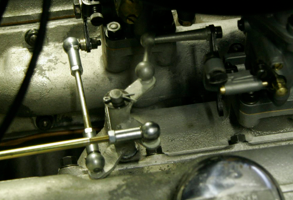
Last bits from the machinist
A couple of Saturday’s ago – Scotty the mechanic and I met at the machinists. Scotty came to finish up some loose machining and to pick up the remaining parts. All in all, it was a good day – as the parts are all now down with Scotty and work on the motor can go ahead.
Scotty has started the engine assembly, and has the crank, cam and pistons in the block. Some 12 hours of fitting con rods (and babbitt) to the crank, with some reference to radiused journals….
But all is now straight and aligned true, so it should fit. Bill (the machinist) is showing off the oil pan – but the real work was elsewhere. And carefully done, very thoughtfully. Hard to find such work.
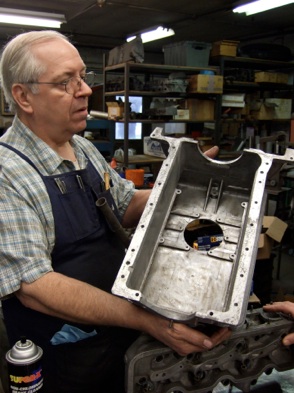

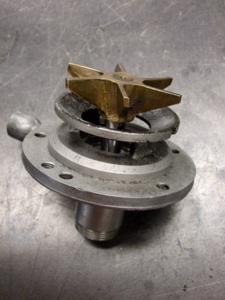








left – water pump, reworked for modern seal at front.
right above – Scotty checking out the timing chain tensioner and its shaft that runs in needle bearings.
right – replacement brass plugs for the oil journals in the block. Similar to Lampredi engines.
above – refinished head. Surfaces are good and clean.
left – steel inserts at head studs, for better bearing.
below – Lancia date stamps on the head – on the left, Feb. 19, 1952. On the right, just 1952.
left – numbered con rods, with babbitted journals. Note how slender the neck is on the early rods.
right – the rod – with new bushing for slightly different wrist pin. Overall, the weight of the new pistons, rings, wrist pin and conrods were very close to the original, so rebalancing of the crank was not needed. Too often the cranks are messed up with rebalancing, and leaving well enough alone was the wiser course.
Line boring
Its always a challenge to write about something you know very little about. I don’t know whether its line boring, or even “align boring”, but its the cutting of the babbitt main bearings, to fit the crank in the block. This seems to be the big hangup right now, as the entire restoration is now awaiting this work.
With the Lancia type front and rear seals being threaded metal type (not modern rubber), the alignment of the bearing work (in the block) with the two end fittings (seals) is most critical. It all has to line up. A few thou difference between the center of the crank at the seal and at the bearings will mean a crank that doesn’t spin….thus the boring fixture has to made to fit not just the four main bearings, but the two seals as well, so that all is on one centerline. And there is little room for error: get it wrong, and it will require new babbitt to be made for the bearings.
The joy of shell bearings in the later cars is that this is not an issue – fit them up, and it should all fit. So the pioneers with the earlier cars have a bit more difficulty here.
I’m told the fittings have finally been made, and that early start at taking boring passes may soon commence. Let others take note: getting all this stuff to line up is very critical, and not so easy. Maybe in Turin there is a machinist who has this all set up, but not here!
Videos
There are some nice moments of Aurelias on the web. Not too many, but a few.
Aurelia B24 Spider movie.
Il sorpasso”, a rather peculiar Italian movie of 1962, with a B24 convertible, some long moody shots, and a fast start with a car that needs paint.
Flaminia vs. Citroen. Thanks to Huib Guerink for finding this one.
Ascari Musso Castellotti Portago Collins F1, all of whom died in the late 1950’s. Good somber piece, which led to:
Le Mans 1955 has no Lancias, but is a fine period British commercial production. Highly recommended.
Recently, someone found a history of Lancia in small videos:
from “Et dieu…Créa la Femme”
Colorado Grand – 2007
For more, see Colorado Grand 2007 – by SmugMug
B20 and suspension mounts
We lost a B20 last month. It was a good unrestored car, but there was a failure (rare in the Lancia world) and the car very much damaged. The story follows:
The rear suspension on the de Dion cars is attached to the body via rear leaf springs. These are mounted to the body at their end shackles by welds, with both some plug welds and a bead weld. Their general location is noted above (in red) although the left one is just off the picture.
Over time, these weld points may weaken. Ed Godshalk found this out with his 4th series B20 in Oregon. His car was in good shape, with a rebuilt motor and crisp mechanicals. He had used it quite a lot over the years. But a few weeks ago, his rear leaf spring mount let go and the car spun out of control. Off the road, into the ditch, down the hill, and upside down. Ed and his passenger got out safely, luckily, although with some difficulty.
After hearing this I went and checked our B24, which had been restored by Bob Williams in Pittsburgh. Hats off to Bob – the rear mounts were reinforced and heavily welded. So too was the front axle, where it mounts to body.
Ed has written up his accident, in the attached PDF file (click on photo below). Sad but true.
WARNING – check the welds!

Infrastructure
There’s a lot of stuff in old cars. And all of it has to be made working, cleaned up, put back, and aligned. Like infrastructure, it takes time but is very important to get right.
Nothing really fits easily: a trim ring once dipped and polished won’t have the same shape it did when fitted; a rubber gasket will have been remade and will be a bit thick; doors when fitted with all their rubber and trim will need to be re-aligned. A push button lock for a glove box with its aged plastic trim, now warped, has to be gently prodded into a second life. Its all this that makes a handmade car restoration take so long.
Some interesting details include
– these early cars have the teardrop covers on the headlights. There is a second flat glass pane behind.
– the gas tank has the plunger stick, a bakelite cover, and also a neat alum lid to cover it all.
– the doors hinge at an angle, out and up, so as to clear the curb when opened. This geometry makes alignment all the more fun!
A few months ago, there was fear about all the little bits, and would they actually ever get on the car. Now, many have been. Current progress includes:
– front headlights, foglights, rear trunk lights, trim
– dash now with instruments , knobs, wiper motors, etc.
– glove box and door hooked up
– door handles, latches, and door/window trim (fussy)
– gas tank mounted with new lines and vents.
Next to come includes:
– emergency brake
– pedal stanchions
– refitting of front rubber mat and heater
– gear shift linkage.
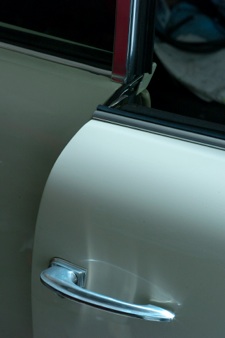

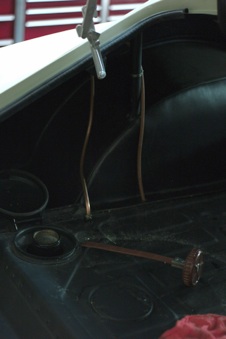


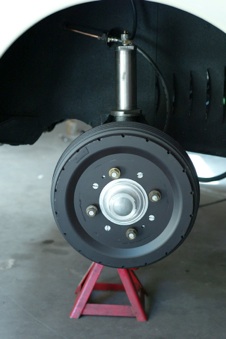

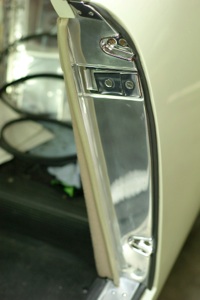
Colors – Glasurit and Lancia
Paint colors remain an issue. Original colors are no longer made; original samples, if found, have faded.
Finding and matching early Lancia paint colors is quite difficult. There is information on what colors were used, but typically Max Meyer numbers are given. I know of no conversion chart for them to current paints.
Lechler (Europe) made a major committment in the early 1990’s to convert vintage paint colors to current numbers, and they maintain a pretty current listing. Their list from early 1990 is on this blog, dated 5.2/06.
Unfortunately, Lechler is not represented in the US, and thus for the American, this is of little help (except for the friendly European, who sent paint swatches to me – thanks again!).
Glasurit and PPG are much more common in the US. In 1990, Glasurit paint chip books had a section on Lancia and listed paint codes back to 1968, thus of use to US Lanciste. The first page (of eleven) is shown above – but rather than rely on scans for colors, one should use the name and number and have the paint made up – and see if you like it.
There is a catch tho – some of the paints have slightly different formulas for different years! There are multiple listings for: blu Lancia, amaranto, beige mirabello and rosso corsa. Still, one can work from this number list and make pretty good progress.
Thanks to Ed Levin (Fulvia, Los Angeles) for this information.
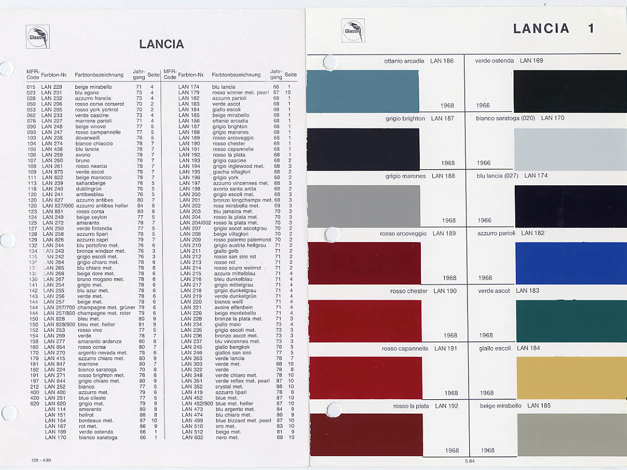
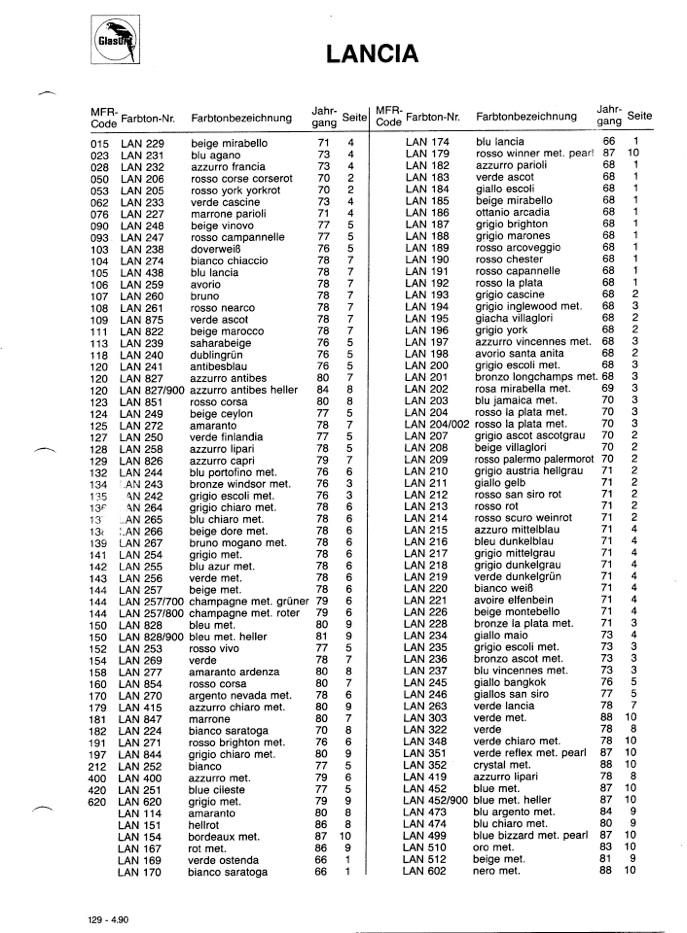
B20 series 1 and 2
Did Lancia change the heads, also? But of course….
One aspect of Aurelias is figuring how things change through its life. For us in America, the later series cars are far more common, with the 2.5 liter motors. Series 3 are rare, series 4 are desired, and series 5 or 6 more common (if one might use such a word for such rare cars).
But all these 2.5 liter motors, and with the exception of the series 3, are fairly similar. Yes, the series 5 and 6 have a bigger cam and lifters, carburetor,, but these reasonable variations can be readily understood. These changes are minor compared to the early cars – where even the two liter motors in the s. 1 and s.2 are in fact quite different. For these two motors, the heads, the blocks, the pistons are different, the carbs are changed, the intake manifolds are different….wow.
This comes about because the s. 1 motor is essentially derived from the 1.8 liter B10 Berlina motor. Its heads use the rocker configuration to that motor, but the s. 1 B20 motor is bigger (2 liter) and has two single barrel carbs, but it has the same cam tho as the Berlina.
In the second series motor, things really start to change. While it uses the same cam, this motor has a different rocker orientation (skewed to the crank’s axis, not parallel like the Berlinas), domed pistons, and its carbs are on different manifolds.
As a result of the skewed rockers, the heads are different – and unique to the second series. So too, surprisingly, is the block.
A comparison of the head gaskets for both motors shows traces of this. Above are shown head gaskets for two liter motors, where it is easy to see differences. Both head gaskets are old stock – one for the first series, the other second series. So which is which?
Inspection of the the later s. 2 head reveals large water flow areas in the head, especially in the center, between each of the cylinders, up by the intake and between the pushrods. These show up in the s.2 gasket with there being 3 large circles, between the pushrods, in an angled pattern (see image on left). So too, the s.2 head has larger chambers at both ends of the head, and there is one more hole added at the two sides of the head gasket for this. Big changes in thehead, but only small modifications to the gasket.

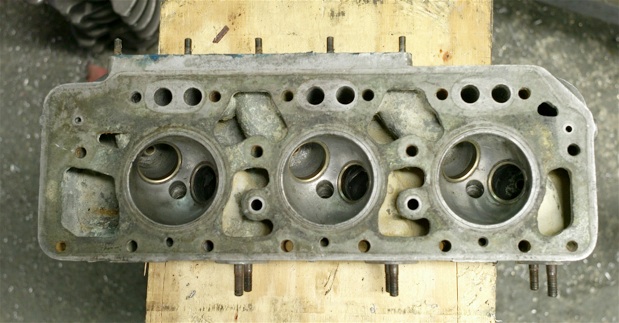
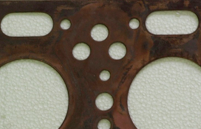
s. 2 gasket (above), and head below.
s. 2 head with rocker arm bases for skewed valves. All the later 2.5 liter engines used this arrangement. None of the Berlinas did.
s. 1 above, s.2 below